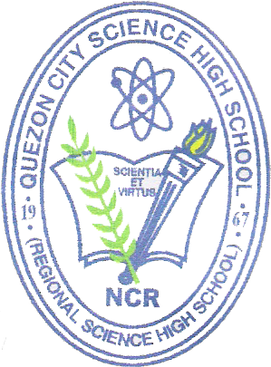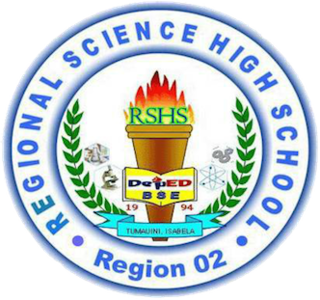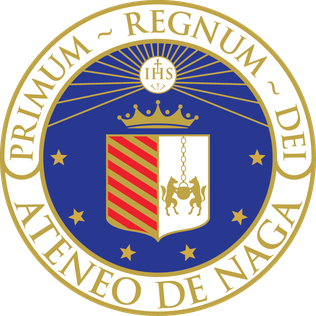
Quezon City Science High School is the Regional Science High School for the National Capital Region. It is the premier science high school of Quezon City and is regarded as among the prestigious science triumvirate of the Republic of the Philippines, along with the Philippine Science High School and Manila Science High School. It is located at Golden Acres Road, Corner Misamis Street, Bago-Bantay, Quezon City, Philippines. Founded on September 17, 1967, it was appointed as the Regional Science High School for the National Capital Region since 1998.
The Regional Science High School Union (RSHS-Union) is a specialized system of public secondary schools in the Philippines, established during the academic year 1994-1995. It is operated and supervised by the Department of Education, with a curriculum heavily focused on math and science. It remains within the ambit of the Department of Education, unlike the specialized science high school system of national scope, the Philippine Science High School.
The Rizal National Science High School, commonly known as RNSHS, RiSci, or Rizal Science is a public science high school on Jose P. Rizal Ave., Brgy. Batingan, Binangonan, Rizal, Philippines. It was founded in 1998.

The Regional Science High School for Region VI (formerly Aklan Development High School / Science Development High School of Aklan / Science Development National High School is a public secondary science school supervised by the Department of Education. It is located in Old Buswang, Kalibo, Aklan, Philippines.
Partido State University is a research regional state higher education institution in Partido Area at the province of Camarines Sur, Philippines. It is an ISO 9001:2015 certified public university.

Regional Science High School is located at Camp Samal, Arcon, Tumauini, Isabela, in the Cagayan Valley Region. Its present principal is Romel Ricardo. Past principals include Mr. Inocencio T. Balag, Mrs. Catherine Angela Taloza, Dr. Fabio M. Macalling, Jr., Mr. Peter Batarao, and Ms. Nelia Z. Angoluan. Regional Science High School has a curriculum that specializes in science and mathematics.

Ateneo de Naga University and also referred to by its acronym AdNU, is a private Catholic Jesuit basic and higher education institution run by the Philippine Province of the Society of Jesus in Naga City, Camarines Sur, Philippines. It was established in 1940 when the Jesuits took over the administration of the diocesan school, Camarines Sur Catholic Academy. The Jesuits renamed the school Ateneo de Naga after taking control. The Jesuits were naming all the schools that they were opening at that time Ateneo. Ateneo de Naga was the fourth school named Ateneo by the Jesuits. Typical of universities in the Philippines, AdNU has primary and secondary departments, which are both coeducational.
Cordillera Regional Science High School (CRSHS) is a public high school located in La Trinidad, Benguet, Philippines. It serves as the campus of the Regional Science High School Union system for the Cordillera Administrative Region.
Mandaue City Science High School (MCSHS) is a secondary school founded in 1996 in Opao, Mandaue City, Philippines. It transferred to Ibabao-Estancia, Mandaue City in 2008.
The Lipa City Science Integrated National High School is a public science high school located in Lipa City, Batangas in the Philippines. It is a DepEd-recognized science high school and one of the three science high schools in the province of Batangas, the others being the public Batangas Provincial Science High School in Batangas City and the private Batangas College of Arts and Sciences Inc., Lipa City.
Caraga Regional Science High School is a public school in San Juan, Surigao City, Philippines. It is the leading school in the Division of Surigao City with high MPS during the annual National Achievement Tests (NAT), and has been consistent in making its name in Division, Regional, National and International level contests.

The Polytechnic State University of Bicol (PSUB) is a state university in Nabua, Camarines Sur, Philippines. It is mandated primarily to provide higher technological, professional and vocational instruction and training in fisheries, trade, as well as short term technical and vocational courses, as the Board of Trustees may deem necessary, and shall promote research in the exploration and conservation of natural resources in the province. Its main campus is located in Nabua, Camarines Sur.

Taguig Science High School (TSHS), also known as TagSci or TagSat, is a public science high school located in San Miguel, Taguig, Philippines. It is one of the three science high schools of the city, and is managed and administered by the Schools Divisions Office of Taguig City and Pateros (SDO-TaPat). TSHS traces its roots from the Special Science class of Signal Village National High School.

The Camarines Sur National High School, also called CamHi, is the oldest national high school in Camarines Sur and one of the biggest public secondary schools in the Bicol Region, Philippines, having a student population of 11,899 in the school year 2021–2022. It was established in 1902.
Tinago National High School is a public national high school in Naga City, Bicol Region, Philippines. It is the seventh established public secondary high school in the Division of Naga City. It was founded in 2002, and its current principal is Ms. Sonia D. Teran, Ph.D.
Davao Oriental Regional Science High School (School I.D. 304328) is a public science high school supervised by the Department of Education. The school was established on May 28, 2009, through the R.A. No. 9630 as the Regional Science High School for Region XI: Davao Region. It is located in Mati City, Davao Oriental, Philippines. The school is colloquially known as "DORSHS", "RegSci", or simply "RS".
The Gusa Regional Science High School - X colloquially RegSci, GSci or RS, is the Regional Science High School for Region X - Northern Mindanao. It is a specialized public science high school supervised by the Department of Education located in Gusa, Cagayan de Oro, Philippines. It is the premier science high school of Northern Mindanao, and one of the two science high schools in the region, together with the Philippine Science High School Central Mindanao Campus. The school was established in 1994 as Gusa National High School - RSHS Annex. It became the Regional Science High School for Northern Mindanao in 2002 through the House Bill No. 3000 of the 15th Congress. From the name Gusa National High School-Regional Science High School Annex, it was then changed into Gusa Regional Science High School - X, through the RA 10267.

Tagum National Trade School (TNTS) is the only vocational of the five main public high schools in Tagum City, under the jurisdiction of the DepEd Division of Tagum City and Technical Education and Skills Development Authority. It was founded on August 1, 1972. The institution cater students from Tagum City and the province of Davao del Norte.
Eastern Visayas Regional Science High School is one of the campuses of the Regional Science High School Union under the supervision of the Bureau of Secondary Education of the Department of Education. It is located at San Roque, Catbalogan, Samar along the Arteche Boulevard.
Information Communications Technology is usually included in the Home Economics and Livelihood Education program in grade school and taught through the Technology and Home Economics program in high school. The recent status of ICT education in the Philippines, along with other Southeast Asian countries, was surveyed by the Southeast Asian Ministers of Education Organization (SEAMEO) in 2011. Using the UNESCO model of ICT Development in Education, the countries were ranked as Emerging, Applying, Infusing or Transforming. The Philippines were ranked at the Infusing stage of integrating ICT in education, indicating that the country has integrated ICT into existing teaching, learning and administrative practices and policies. This includes components such as a national vision of ICT in education, national ICT plans and policies, complementary national ICT and education policies, professional development for teachers and school leaders, community or partnership and teaching and learning pedagogies. A 2012 study reported that public high schools in Metro Manila had a computer to student ratio of 1:63. While 88 percent of schools have internet connections, half of the students claimed not to be using it.









